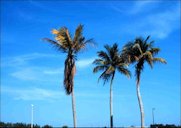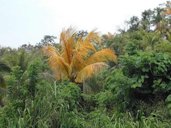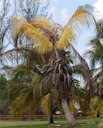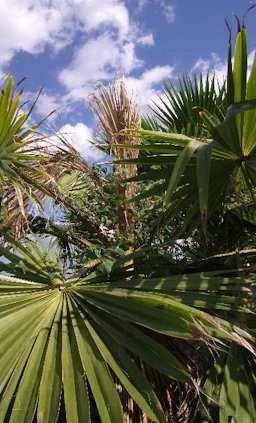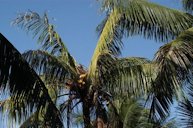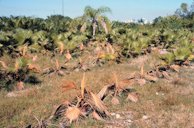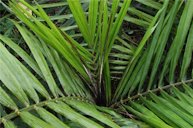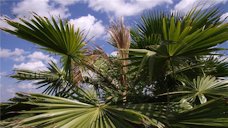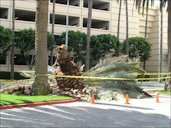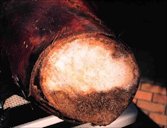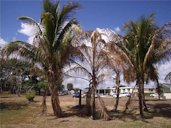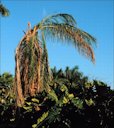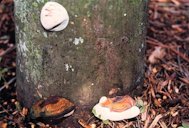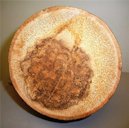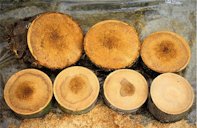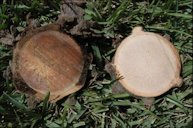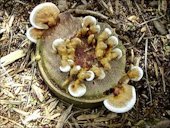| Coconut Palm Diseases | ||||||||||||||||||||||||||||||||||||||||||||||||||||||||||
|---|---|---|---|---|---|---|---|---|---|---|---|---|---|---|---|---|---|---|---|---|---|---|---|---|---|---|---|---|---|---|---|---|---|---|---|---|---|---|---|---|---|---|---|---|---|---|---|---|---|---|---|---|---|---|---|---|---|---|
 Fig. 1 Fruits that prematurely dropped from Cocos nucifera due to Lethal Yellowing. Note dark, water-soaked calyx (stem) end. 
Fig. 9  Spear leaf and next youngest leaf exhibiting typical symptoms of Phytopthora bud rot 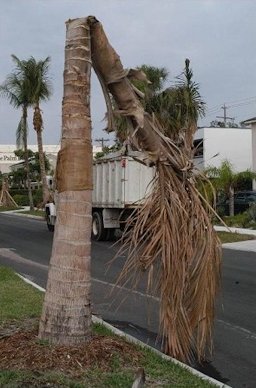
Fig. 18 C. nucifera trunk collapsed upon itself due to Thielaviopsis trunk rot  Fig. 26  Sabal palmetto (sabal palm) with wilted and dessicated leaves due to Ganoderma zonatum infection 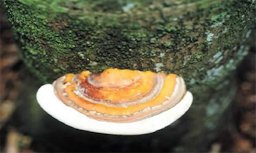 Fig. 27  Basidiocarp (conk) of G. zonatum. Note glazed reddish-brown top surface and white undersurface. The "straight" side of the conk is directly attached to the trunk. There is no "stem" or "stalk" that attaches the conk to the trunk.
|
Leathal Yellowing
(Fig.1) Caused by a tiny organism called a phytoplasma Lethal yellowing (LY) is a phloem-limited disease caused by a phytoplasma and transmitted by a planthopper. Historically, LY has occurred only in the southern one-third of Florida. The disease was observed for the first time in Sarasota and Manatee Counties on the west coast of Florida in 2007 and in Indian River County on the east coast in 2012. LY symptoms are highly variable among Cocos nucifera (coconut) cultivars and among other palm genera. General symptoms are fruit drop and flower necrosis, Foliage discoloration and Death of the apical meristem (bud). Palms with greater than 25% leaf discoloration or a dead apical meristem (bud) due to LY should be removed. Management of LY includes trunk injections of oxytetracycline HCl (OTC) every four months, and planting of palm species that are not hosts of LY. Very few palm species native to Florida and the Caribbean Basin appear to be susceptible to LY. 1
Fig. 2. Foliar yellowing symptoms of C. nucifera due to Lethal Yellowing Fig. 3. Green form of 'Malayan Dwarf' C. nucifera with Lethal Yellowing exhibiting discoloration of leaves (grayish-brown rather than yellow) and overall wilted appearance Fig. 4. 'Jamaica Tall' C. nucifera on left is exhibiting Lethal Yellowing symptoms of solitary, yellowed leaf ("flag leaf") in middle of canopy plus dead leaves hanging down around trunk Fig. 5. Foliar browning symptoms of Lethal Yellowing on Phoenix dactylifera Fig. 6. The leaves of dwarf cultivars of C. nucifera affected by lethal yellowing usually do not turn yellow Fig. 7. Leaf yellowing symptoms on C. nucifera Fig. 8. C. nucifera spear leaf is dying just as the last leaves are discoloring Further Reading Lethal Yellowing (LY) of Palm, University of Florida pdf Phytopthora Bud Rot (Fig.9) Caused by the pathogen Phytophthora palmivora The most common bud rot pathogen in Florida is P. palmivora. Thielaviopsis paradoxa may cause this disease also. The first symptom is discoloration and wilting of the spear leaf and wilting/discoloration of the next youngest leaf. If severe, the spear leaf easily pulls from the bud. In palms with a canopy above eye level, this first symptom is often missed. Instead, a lack of new leaves and an open-topped crown are often the first symptoms to be observed. Because the bud is dead, no new leaves emerge. Older leaves remain healthy for months after the bud dies. In a nursery, water management and sanitation are critical for bud rot management. Preventive fungicide applications are useful in a nursery situation for bud rot, but less so in a landscape with mature palms (palms with trunks). Bud rot is also observed in association with cold damage. Cold damage allows entry of secondary pathogens, both fungi and bacteria. 2
Fig. 11. Spear leaf and next youngest leaf exhibiting typical symptoms of Phytopthora bud rot Fig. 12. Bud rot of C. nucifera: no new leaves are emerging and crown is open-topped, while older leaves in canopy look healthy at this time Fig. 13. Multiple Washingtonia robusta in this field nursery are being affected by Phytophthora bud rot; Tthose most affected were juvenile palms in a low-lying area Fig. 14. The initial site of infection is on the unopened leaf blade of the spear leaf Fig. 15. The spear leaf of this seedling palm has already died due to a bud rot pathogen; while the surrounding leaves appear healthy, the bud (apical meristem) of this palm has already rotted, and no new growth will occur Fig. 16. The spear leaf and next youngest leaves of this juvenile palm are exhibiting extensive necrosis due to a bud rot pathogen Fig. 17. The spear leaf and the next youngest leaves are desiccated and necrotic due to bud rot Further Reading Bud Rot of Palm, University of Florida pdf Butt Rot of Palms, Florida Department of Agriculture pdf Thielaviopsis Trunk Rot (Fig.18) Caused by the fungus Thielaviopsis paradoxa Due to this disease, the palm trunk either collapses on itself or the canopy suddenly falls off the trunk, often without warning. The palm canopy may appear healthy prior to collapse. Except for “stem bleeding,” which is common in C. nucifera (coconut), there may be no symptoms prior to collapse of the palm. Only fresh trunk wounds will become infected by the fungus, so disease management includes limiting man-made wounds to the palm trunk, especially the upper third of the trunk. There are no other methods to prevent or cure this disease. The palm should be removed immediately, and the diseased trunk portion destroyed but not recycled. 3
Fig. 19. The canopy of this Phoenix canariensis fell off of the trunk due to T. paradoxa trunk rot Fig. 20. W. robusta with trunk collapsed on itself due to Thielaviopsis trunk rot Fig. 21. Cross-section of W. robusta trunk illustrating that the rot caused by T. paradoxa occurs on only one side of the trunk and moves from the outside to the inside of the trunk Fig. 22. Cross-section of C. nucifera trunk illustrating that the rot caused by T. paradoxa occurs on only one side of the trunk and moves from the outside to the inside of the trunk Fig. 23. "Stem bleeding" on a C. nucifera due to infection from T. paradoxa Fig. 24. An example of "stem bleeding" on a C. nucifera trunk; the top of the blackened area was very soft and could be easily pushed in with the fingers Fig. 25. The canopy of C. nucifera in the center is wilted and necrotic due to a trunk infection by T. paradoxa; the infection site was just below the oldest leaf base Further Reading Thielaviopsis Trunk Rot of Palm, University of Florida pdf Ganoderma Butt Rot (Fig. 26,27) Caused by the fungus Ganoderma zonatum This fungus degrades the lining in the lower 4–5 feet of the trunk. It does not cause a soft rot, so the truck seems hard. All palms are considered hosts of this fungus. This fungus is not a primary pathogen of any other plant family. Symptoms may include wilting (mild to severe) or a general decline. The disease is confirmed prior to palm death by observing the basidiocarp (conk) on the trunk. This is a hard, shelf-like structure that will be attached to the lower 4–5 feet of the palm trunk. However, many diseased palms do not produce conks prior to death. A palm cannot be diagnosed with Ganoderma butt rot until the basidiocarp (conk) forms on the trunk, or the internal discoloration of the trunk is observed after the palm is cut down. The fungus is spread by spores, which are produced and released from the basidiocarp (conk). Conditions that are conducive for disease development are unknown. There are currently no cultural or chemical controls for preventing the disease or for curing the disease once the palm is infected. A palm should be removed as soon as possible after the conks appear on the trunk. Remove as much of the stump and root system as possible when the palm is removed, or grind the stump. If neither is possible, monitor the stump for conks, and remove the conks as soon as they form. Because the fungus survives in the soil, planting another palm back in that same location is not recommended without special precautions. 4
Fig. 28. Syagrus romanzoffiana (queen palm) dying from Ganoderma zonatum; only the spear and one other leaf remain green Fig. 29. Three phases of basidiocarp (conk) development of G. zonatum; the white "button" near the top of the picture is the beginning stage of the conk; the lower-right structure is a mature conk; the lower-left structure is also a mature conk, but it is an old one; the underside of this conk is no longer white Fig. 30. A cross-section through a Cocothrinax sp. trunk with G. zonatum butt rot; the darkened area in the center is a symptom of the trunk rot Fig. 31. Cross-sections of lower trunk of S. romanzoffiana infested with G. zonatum; Top-left section is bottom section and remaining sections progress up the trunk; note darkening of wood due to fungal degradation (rot) Fig. 32. Comparison of pygmy date palm sections that are either healthy (right) or diseased (left) with G. zonatum Fig. 33. Cut palm stump with numerous basidiocarps (conks) of G. zonatum forming on it; the conks in the palm stump's center are crowding each other and thus are forming into shapes different from those on the outer edges of the stump Fig. 34. Spore release from mature conks (same stump as Fig. 33) has resulted in reddish-brown appearance of conks and surrounding area Further Reading Ganoderma Butt Rot of Palms, University of Florida pdf |
|||||||||||||||||||||||||||||||||||||||||||||||||||||||||
| Bibliography 1 Bahder, Brian W., and Ericka E. Helmick. "Lethal Yellowing (LY) of Palm." Plant Pathology Dept., UF/IFAS Extension, PP-222, Original Pub. Oct. 2005, Rev. Aug. 2007, Aug. 2009, Aug. 2012, Oct. 2015, and Nov. 2018, Reviewed 30 Aug. 2021, AskIFAS, edis.ifas.ufl.edu/pp146. Accessed 14 Mar. 2019, 17 Mar. 2024. 2 Elliott, Monica L. "Bud Rot of Palm." Plant Pathology Dept., UF/IFAS Extension, PP-54, Original Pub. Jan. 2006, Rev. Oct. 2015, Reviewed 30 Nov. 2021, AskIFAS, edis.ifas.ufl.edu/pp144. Accessed 1 May 2014, 14 Mar. 2019, 17 Mar. 2024. 3 Elliott, M. L. "Thielaviopsis Trunk Rot of Palm." Plant Pathology Dept., UF/IFAS Extension, PP-219, Original Pub. Jan, 2006, Rev. Jan. 2009, May 2015, and Jan. 2018, Reviewed 29 Nov. 2021, AskIFAS, edis.ifas.ufl.edu/pp219. Accessed 1 May 2014, 14 Mar. 2019, 17 Mar. 2024. 4 Elliott, M. L., and Timothy K. Broschat. "Ganoderma Butt Rot of Palms." Plant Pathology Dept., UF/IFAS Extension, PP-54, Original Pub. Nov. 2000, Rev.June 2012, May 2015, and Jan. 2018, Reviewed 29 Nov. 2021, AskIFAS, edis.ifas.ufl.edu/pp100. Accessed 1 May 2014, 14 Mar. 2019, 17 Mar. 2024. Photographs Fig. 1,2,3,4,5,13 Harrison, N. A. "Lethal Yellowing (L.Y.) of Palm." UF/IFAS, AskIFAS, edis.ifas.ufl.edu. Accessed 28 Apr. 2014. Fig. 4 Broschat, T. K. "Lethal Yellowing (L.Y.) of Palm." UF/IFAS, AskIFAS, edis.ifas.ufl.edu. Accessed 23 Apr. 2014. Fig. 5,6,7 Harrison, N. A. "Lethal Yellowing." Screening Aid, A Resource for Pests and Diseases of Cultivated Palms, Florida Department of Agriculture and Consumer Service, Division of Plant Industry and Identification Technology Program, CPHST, PPQ, APHIS, USDA; Fort Collins, CO., 2011, itp.lucidcentral.org/id/palms/resource/index.html. Accessed 30 Apr. 2014. Fig. 8 Elliott, M. L. "Lethal Yellowing." Screening Aid, A Resource for Pests and Diseases of Cultivated Palms, Florida Department of Agriculture and Consumer Service, Division of Plant Industry and Identification Technology Program, CPHST, PPQ, APHIS, USDA; Fort Collins, CO., 2011,itp.lucidcentral.org/id/palms/resource/index.html. Accessed 30 Apr. 2014. Fig. 9 Broschat, T. K., and Elliott, M. L. "Bud Rot of Palms." UF/IFAS, AskIFAS, edis.ifas.ufl.edu. Accessed 23 Apr. 2014. Fig.11,12 Elliott, M. L. "Bud Rot of Palms." UF/IFAS, AskIFAS, edis.ifas.ufl.edu. Accessed 23 Apr. 2014. Fig. 14,15,16,17 Elliott, M. L. "Bud Rot." Screening Aid, Resource for Pests and Diseases of Cultivated Palms, Florida Department of Agriculture and Consumer Service, Division of Plant Industry and Identification Technology Program, CPHST, PPQ, APHIS, USDA; Fort Collins, CO., 2010, itp.lucidcentral.org/id/palms/resource/index.html. Accessed 30 Apr. 2014. Fig. 19 Donselman, H. "Thielaviopsis Trunk Rot of palm." UF/IFAS, AskIFAS, edis.ifas.ufl.edu. Accessed 30 Apr. 2014. Fig. 20 Howard, F. S. "Thielaviopsis Trunk Rot of palm." UF/IFAS, AskIFAS, edis.ifas.ufl.edu. Accessed 30 Apr. 2014. Fig. 18,21,22,23 Elliott, M. L. "Thielaviopsis Trunk Rot of palm." UF/IFAS, AskIFAS, edis.ifas.ufl.edu. Accessed 23 Apr. 2014. Fig. 23,24,25 Elliott, M. L. "Thielaviopsis Trunk Rot." Screening Aid, A Resource for Pests and Diseases of Cultivated Palms, Florida Department of Agriculture and Consumer Service, Division of Plant Industry and Identification Technology Program, CPHST, PPQ, APHIS, USDA; Fort Collins, CO., 2011, itp.lucidcentral.org/id/palms/resource/index.html. Accessed 30 Apr. 2014. Fig. 26,27,28,29,30,31,32,33,34 Elliott, M. L. "Ganoderma Butt Rot of Palms." UF/IFAS, AskIFAS, edis.ifas.ufl.edu. Accessed 1 May 2014. Published 1 May 2014 LR. Last update 17 Mar. 2024 LR |
||||||||||||||||||||||||||||||||||||||||||||||||||||||||||


